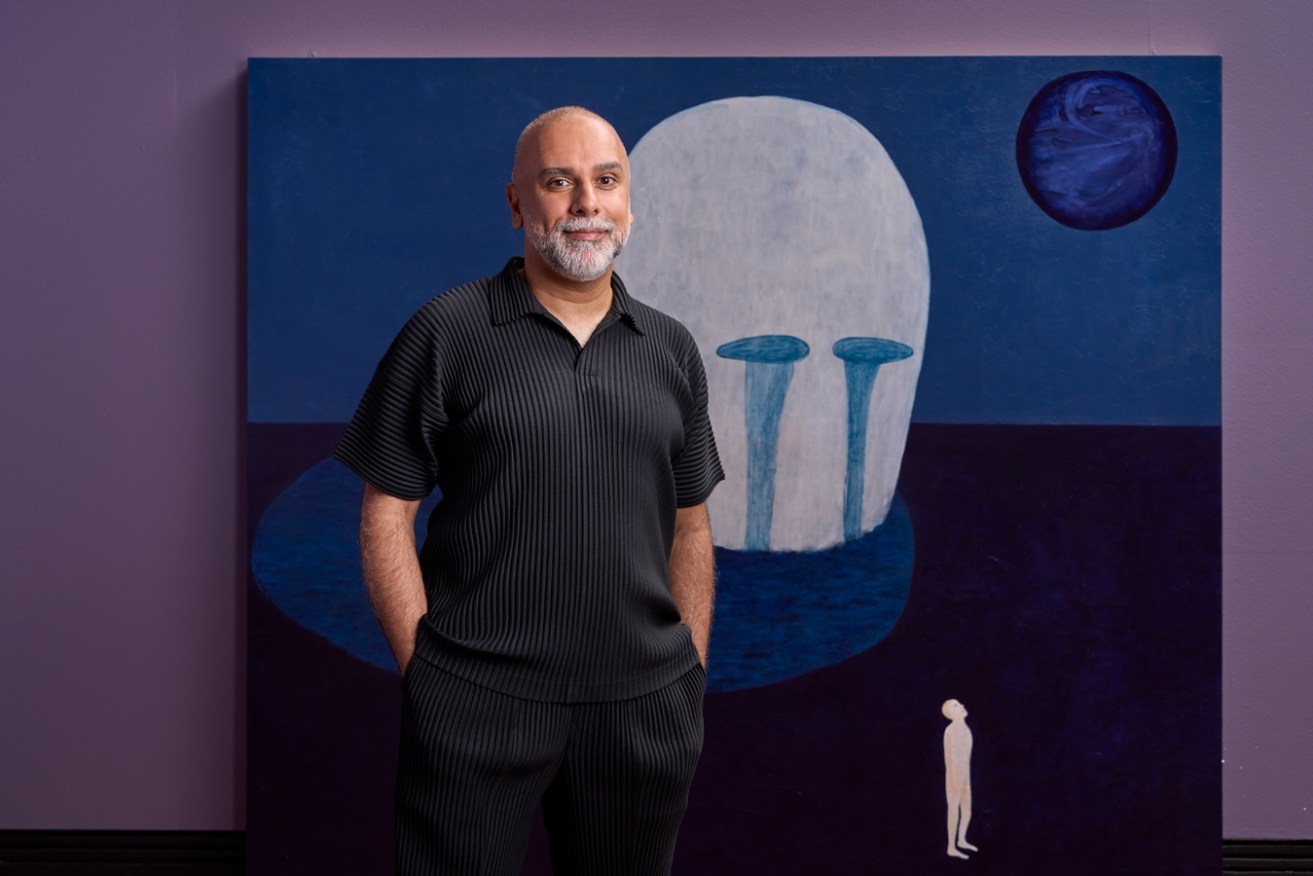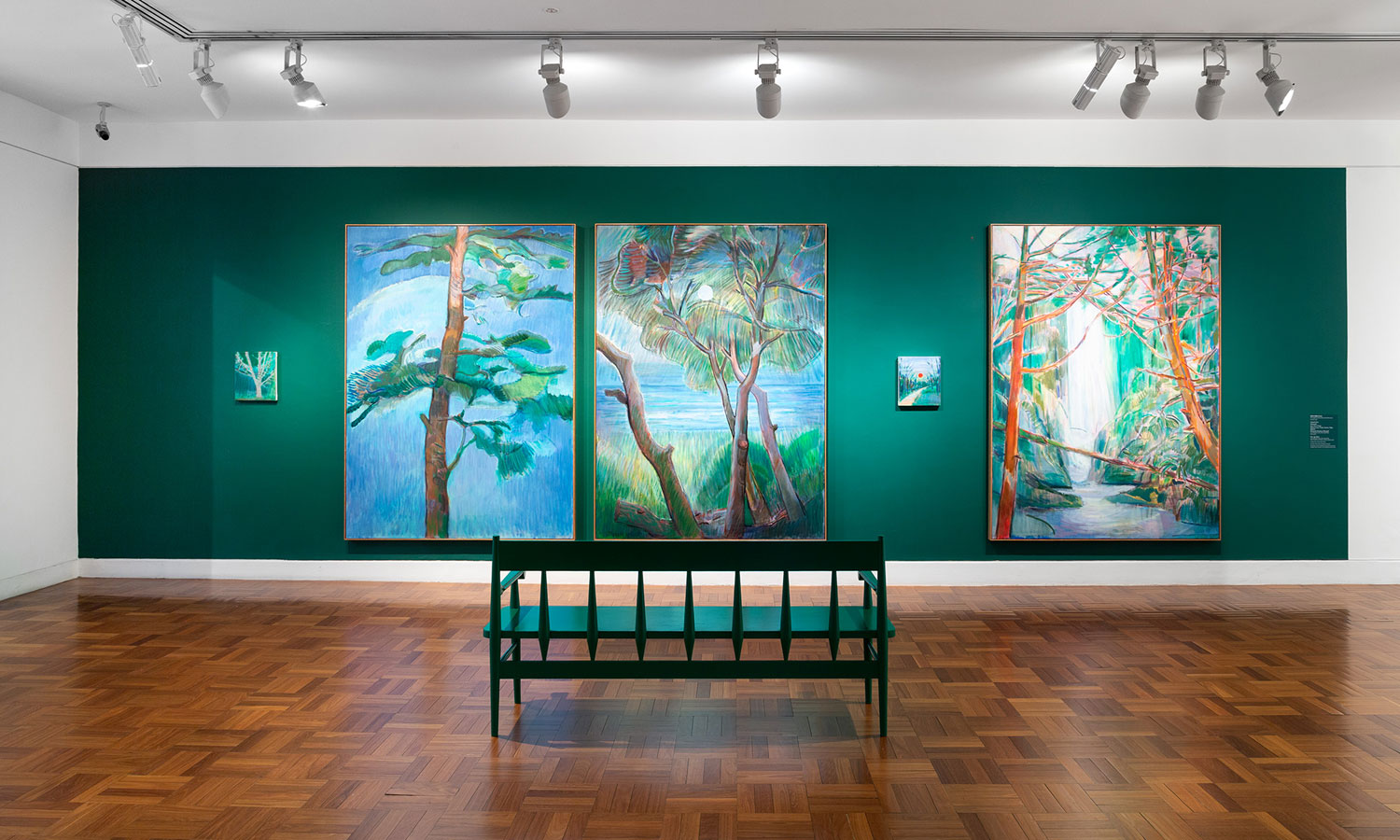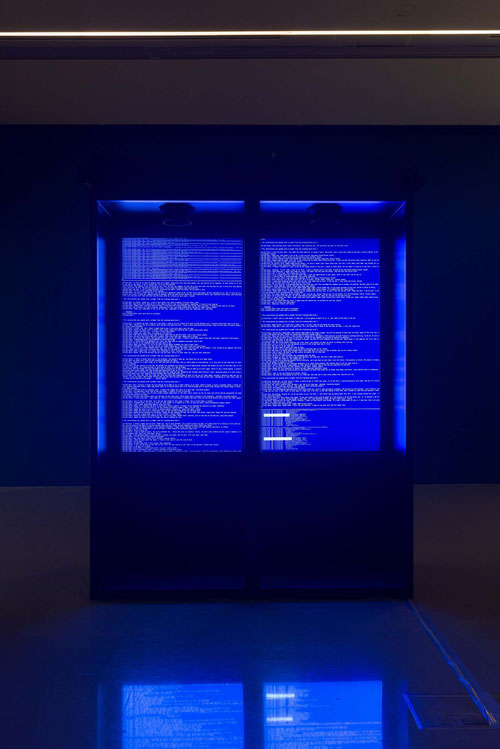Adelaide Biennial offers a place to discover your ‘inner sanctum’
Twenty-four leading contemporary artists present their take on the concept of Inner Sanctum through works ranging from paintings and poetry to video installations and music in curator José Da Silva’s 2024 Adelaide Biennial of Australian Art.

2024 Adelaide Biennial curator José Da Silva in front of a work by Tasmanian artist Heather B Swann. Photo: Sam Roberts / supplied
A large three-panel painting by opal miner turned artist George Cooley greets visitors to the 2024 Adelaide Biennial of Australian Art. Stretching across the wall behind the information desk in the Art Gallery of SA foyer, it captures the striking red and ochre landscape of the Kaṉku-Breakaways – a protected area near Coober Pedy that has never been mined.
“It’s truly one of the most breathtaking landscapes in South Australia,” says Adelaide Biennial curator José Da Silva.
“I knew with this show that I wanted to start with an image of South Australia, so I commissioned George to make not only this, but also a series of other big paintings that are in some of the other galleries that depict the Breakaways… I saw something really potent in his work.”
Cooley, a senior man from the Umoona community on the outskirts of Coober Pedy, has been painting for only around four years but has an intimate understanding of the landscape, having lived on Country for most of his life. He worked as an opal miner from the age of 16, and is also a songwriter, musician and storyteller.
In a video on the AGSA website, Cooley describes the Kaṉku-Breakaways as a living landscape that captivates him and gives him peace.
“Inner sanctum is me being lost in the environment that I think about, that I paint about,” Cooley says. “That’s my inner sanctum – being on Country, standing back there looking at a portrait like this here and imagining myself walking in the middle of it, or sleeping, camping… that to me is an inner sanctum.”

Installation view: 2024 Adelaide Biennial of Australian Art: Inner Sanctum, featuring George Cooley’s My Painted Country 1. Photo: Saul Steed
Da Silva says the idea of an “inner sanctum” – his chosen theme for the 2024 Adelaide Biennial – evokes both the private and sacred spaces people create in their homes and communities as a refuge or sanctuary, and “the faculty of imagination, which allows us to see culture and society differently”.
The 24 contemporary artists and writers he has brought together for the exhibition have interpreted the idea in myriad ways, with their works presented across the gallery in five “parts” or groupings: The Inland Sea (which features Cooley’s painting in the foyer, alongside which is displayed an opal from Coober Pedy on loan from the SA Museum); A Clearing, A Periphery; The River Path; A Quiet Spot, and The Writing of Love and Finding It.
The group of works in A Clearing, A Periphery are about evocations of time and atmosphere and memory, explains Da Silva, noting that this part of the exhibition is named after a textile work by Teelah George which is displayed in the Elder Wing alongside John Russell’s 1891 oil painting A Clearing in the Forest.

An installation view of the Adelaide Biennial featuring Teelah George’s textile work A Clearing, a Periphery. Photo: Saul Steed
Also in the Elder Wing this Saturday, visitors will have the opportunity to hear the Adelaide Chamber Singers performing the new coral work “All Fire is Flesh”, which was composed by Anne Cawrse based on a poem that Da Silva commissioned South Australian poet Kate Llewellyn to write for the Biennial.
Larger works by Teelah George, in which she uses embroidery to map the colour of the sky, can be seen elsewhere in A Clearing, A Periphery, which also includes a series of “time of day” landscape paintings by Seth Birchall – three of which are hung in front of a green bench, made in collaboration with designer Jonathan West and intended to encourage visitors to take some time for contemplation.
Da Silva says a site-specific circular glass work by South Australian artist Jessica Loughlin, Solari, also creates space for reflection. Presented as part of the architecture of the gallery within a structure designed by the late Khai Liew, Solari captures light and changes throughout the day as the light changes.

Installation view: 2024 Adelaide Biennial of Australian Art: Inner Sanctum, featuring works by Seth Birchall. Photo: Saul Steed
There is plenty to explore within the other parts of the exhibition, too, from a room full of colourful 1:1 scale drawings of doors by Nik Pantazopoulos that are linked to his memories and connected to his cultural upbringing, sexual identity and experience as a Greek migrant in Melbourne, to a video installation by Jacobus Capone that shows him – both in close-up and at a distance – dragging a hunting knife across the face of a glacier in the Norwegian archipelago of Svalbard, highlighting humans’ imprint on nature.
Pantazopoulos’s door series, Elevations, is said to have had its genesis in Melbourne’s long COVID lockdown – and indeed the Biennial theme itself is a response to pandemic lockdowns and restrictions.
Da Silva tells InReview he was interested in how the pandemic led to people having a different kind of relationship with their homes and communities. Creating spaces of refuge or sanctuary – a kind of “inner sanctum” – was something we all did, albeit in different ways.
“And for me, the public art museum is the ultimate sanctuary. It’s the place that invites everyone in, to discover new things, see different lived experiences, learn something new about the world and perhaps learn something new about yourself.”

Paul Knight’s Naked Souls, 2023, 2 OpenAi GPT-2 open-source artificial intelligence large language models, computer console, monitors, steel cabinets and sound. Courtesy of the Artist, © Paul Knight. Photo: Christian Capurro
Towards the end of the exhibition, in A Quiet Spot on AGSA’s ground floor, visitors will find Tasmanian artist Heather B Swann’s Last Night on Earth, an installation presented in a darkly lit space that features sculptures and paintings representing fading memories and what is described as “the joy of letting go”.
And Da Silva has opted for an optimistic finale for his Biennial with two works offering different perspectives on love. The first is a multi-channel sound installation presented using pendant speakers suspended from the ceiling of the Melrose Wing, through which visitors hear members of the Sydney Gay and Lesbian Choir singing a vocal arrangement of a poem titled This is How We Love, by artist and poet Jazz Money.
An adjacent gallery shows the work of Paul Knight, including a number of intimate photos – displayed alongside paintings from the AGSA collection – that are part of an ongoing series in which he traces his relationship with his partner Peter, and a new work called Naked Souls that is driven by artificial intelligence. For Naked Souls, a pair of screens display an AI-generated “conversation” between Peter and Paul facilitated by two sets of data: real text messages between the pair, and dialogue from a sci-fi novel.
“Paul’s project poses a fascinating question about the capacity of artificial intelligence to understand human love,” says Da Silva. “By giving the machine a real example via messages shared with his partner, he allows audiences to see the experiment play out in the gallery in real-time.”
So can AI understand real love? Visitors reading the conversation can decide for themselves.
The 2024 Adelaide Biennial of Australian Art: Inner Sanctum is at the Art Gallery of SA until June 2. Over the opening weekend (March 1-3) there will be a number of special events, including the live performance of All Flesh is Fire; the First Fridays after-hours program; a ceremonial ringing of artist Lawrence English’s one-tonne bell Proximities, artist talks and more. See the full line-up of events on the AGSA website.
Read more 2024 Adelaide Festival coverage here.
This article is republished from InReview under a Creative Commons licence. Read the original article.
InReview is an open access, non-profit arts and culture journalism project. Readers can support our work with a donation. Subscribe to InReview’s free weekly newsletter here.
![]()




